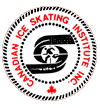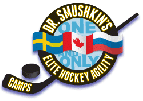



 Dr. Smushkin’s Thoughts
Dr. Smushkin’s Thoughts
Let
me begin what I want to share with you. I will share things that are not
written by the experts in the hockey field. So don’t be surprised or confused if
those things very hard to believe, strange, far out or totally unfamiliar.
There may be a conflict with what I share with you and all that you been taught
in the past.
Today hockey is not just a
national game with old traditional way of thinking. The game is changed from the way we as coaches, scouts and
players are accustomed to perceiving the game, to a new thinking way about the
fascinating sport of a Global hockey!
The Rhythm of the game
The game rhythm is rapid transition from offensive to defensive actions with slow, fast or quick temp (speed). The player who can match the game rhythm transitions smoothly without frictions can have greater chance to win. In addition to that, the game rhythm has rapid transitions of directions (trajectories) of players and the puck. To match that obstacle for the player requires to be a solid skater with “Hockey Sense of Mind”.
In your shift you can match or mismatch game rhythm. If you match, you are adapting to game rhythm changes, you are acting inside game situations. If you wait to adapt yourself after they occur, you become passive participator, you are outside of the game situation. In other words, player must be able to adapt or modify his decisions based on new circumstances and opportunities in each of his shifts.
Rhythmical skating prevails over power skating!
Many programs for hockey players are named “Power Skating”. It is the most misused phrase with two words “Power” and “Skating”.
In survey of 50 Russian hockey specialists we see that absolute strength (power) is the last of eleven essential characteristics of an ideal hockey player (see my book “Hockey Agility”, 1997, pages 59-60).
Very important to understand that for hockey, like in figure skating, the player need skates to present skills on the ice. Both sports have Rhythmical Movement, figure skaters with music and hockey players with cooperative and confrontational moves (with and without puck).
Speed transitions from slow to fast, from slow to quick, from quick to slow and fast automatically develop muscular strength (power).
The secret of speed transitions is not the strength to
push skates, but deep feeling of the rhythm of skates, stick, and puck.
Rhythmical skating and not a power skating are real fundamental skills for
figure skaters and for hockey players.
The Art of Adaptation
Adaptation means shortening the time it takes to adjust to each new game situation during the player’s shift. The player must observe the situation, orient to it, decide what to do and act. The player who can consistently adapt more quickly to the situation will have a significant advantage. Adaptation is the most important skill of hockey tactics.
There are two basic ways to adaptation: by anticipation and by improvisation.
When we have enough situational awareness to understand a situation in advance, we can take preparatory actions. This is anticipation.
At other times we have to adapt to situation on the spur of the moment without time for preparation. This is improvisation.
To be fully adaptable we must be able to do both.
Any hockey skills start in the head, where mind acts in a split-second before body. Dynamic intensity of the game at any age and levels of hockey become restraining factor for the mind “think quickly” and for body “react rapidly and adequately”. It is the mind “above the neck” that directs “below the neck” body activity in the game.
This is a law of nature and the victory comes to ones, who keep on game thinking, trying, experimenting and looking for options. To find the right solution in a complicated situation is the athletic art, which is needed not only in hockey, but in real life as well.
The
basic components of the hockey team are hockey players,
cooperating with their team players and playing against the opposing team. The
hockey players must have athletically skilled body and mind that controls their
performance during the game.
Most
hockey players and coaches spend enormous amounts of time and energy trying to
improve athletically all of the team players, but neglect individual skills
development for each team player. Most coaches introduce team strategy with
team tactical skills which is much more difficult in cognitive level
to understand, especially for Novice level of hockey.
Logically,
cognitive individual skills development has to be introduced to young hockey
players before cognitive team skills. In fact, no one is learning
to play piano or violin in orchestra and any maestro does not teach how to play
piano or violin to his music players.
Traditional
postulate “read and react”, I think, is too old and wrong. The
postulate “thinking and reacting adequately” has much more common
sense today in “real-deal” hockey, because thinking and reacting are cognitive
mental and physical skills.
I
am proud to introduce (in my Schools in
Hockey is not just a game it is
also a Reality Show
The game space has two parts: an ice rink for players and the stands for the spectators.
Because of television, the audience has grown from local, to national, and even
international. Now “hockey shows” can be seen by millions of fans around the
globe on TV or video.
While watching a game, hockey fans also “play hockey”
emotionally, with their eyes and hearts, along with the ups and downs of the
game.
Worldwide TV coverage provides an incredible opportunity
for the players to showcase themselves and promote their spectacular individual
skills. Their creative, unique, and original hockey skills will be acknowledged
and appreciated by the hockey media, as well as by hockey fans.
In hockey, playing solo means that the
player, when performing alone, demonstrates his mastery of the skills as well
as his creativity. When the soloist player is performing, he will capture the
public’s attention by his exceptional moves.
Today, for the new generation of hockey players, it is
extremely important to be part of the hockey show and not just part of the
competition. For the players, it is crucial to be both –an athlete and an
entertainer. Only the coach can’t be
part of the show because he is off the ice and his skills are hidden from view.
Traditionally, the game is the competition between two
teams, when players, with their coaches, do what they must do to
win the game by scoring the most goals.
An impressive hockey
show is based on how the players of both teams perform their
individual hockey skills. This is their
artistic mastery as opposed to their technical skill. Both are required to provide a spectacular show, which becomes a
brilliant game. In this case, players, without coaches, are able
to act individually and determine the best response by utilizing their creativity.
For example, in chess, what the queen does, has a
completely different impact on the game result than what the pawn does. The roles are different. Both of them can make strong moves, but only
the queen can be agile. The “game show”, in my view, requires not only a
high level of the player’s physical skills, but also a high level of creative,
mental and body agility. Creative hockey agility is front and center for
today’s players’ individual development. Players and coaches can’t ignore those
who PAY today to see the game.
Hockey is a team sport but not the same like soccer or other team sports, where players compete on playing field all the time. The hockey players train together in team practices and are not all together in the game. The soccer players train together in the team practices and play the game together.
When and how they learn to prepare to compete, compete and finally train to win?
This
difference manifests itself that hockey player’s and soccer player’s
preparation to competition is based on two different approaches: individual
- for hockey players and group based training
for soccer players.
How
does this affect the hockey player individual development?
Like
former gymnast and figure skater I can say –negatively. In gymnastic
length of performance on the flour or on the apparatus, remind the hockey
shift. Everybody knows how many hours the gymnast prepares himself for this
“shift”. Same situation takes place in the figure skating development.
In
hockey, the coach’s role is limited by intensity of situational unpredictable
game actions. During the game, the coach is the one who guides the team, even
though he himself doesn’t go on the ice. It is next to impossible for the coach to predict various game situations
from off the ice. The coach can guide professional teams with a high level of
athletic experience since they have already the ability to perform under
variable conditions.
With young hockey players, however, this approach hampers the development of independent game thinking with resourcefulness and individual creativity.
Individual skill development in any sport is process which agrees to laws of science. You can’t win systematically if you don’t learn how to compete. You are not ready to compete if you don’t prepare yourself to compete. The lows of natural athletic development can’t be ignored.
In hockey, it is very
often the situation when the common sense is ignored!
The
hockey game is played at a dynamic, complex, chaotic and unpredictable
environment. Hockey, in nature, is the collision of opposing team players
unpredictable in their behavior. Chaotic game environment also brings some
players the chance and opportunity to win the battle. Winning requires knowledge and understanding of
strategy and tactics with technical fighting skills within game battles.
Mastering fighting skills is a unique ability of physical, mental and moral factors that require intensive and continuous training. Without mastering game fighting skills it is impossible to win game battles.
Three Levels of Distance to Win!
There is a distance in any hockey competition between trial and achievement, reality and desire, inconsistency and consistency. This distance has three levels: A - preparation to compete, AA - learning to compete and AAA - training to win.
At “A” level you compete against yourself or “skill
standard” when nature challenges your mind and body in space, time and by
gravity in action. At “AA” level you will be challenged by your team players
and opponents. At “AAA” level you must consistently upgrade your skills in
order to win. Once you overcame that distance you will be “ahead of
action and above the game“.
My Hockey Agility Training System is based on transition of directions, temp, rhythm and motion amplitude.
Hockey, in nature, is a dynamic, complex, chaotic and unpredictable game environment with the collision of opposing team players unpredictable in their behavior. To win the battle it involves the creation of fighting skills, positioning and maneuvering to defeat the opponent.
My Hockey Agility Training is rooted in the biomechanical principles of dynamically changing the speed, motions amplitude, body’s special positions and timing.
Each hockey skill can be developed and performed in all six directions with different rhythmical compositions and changing amplitudes for skates, stick and puck movements.
Basic directions (front, back, left, right, up, down), temporal movement (slow, fast, quick), rhythmical bits (1-3-5-7) are fundamental techniques of individual Hockey Mastery.
Mastering Hockey Agility Skills requires intensive and continuous training. Without mastering these skills it is impossible to win game battles.